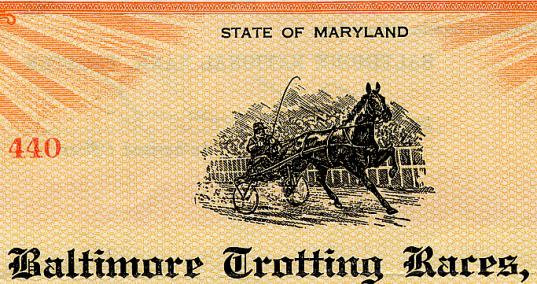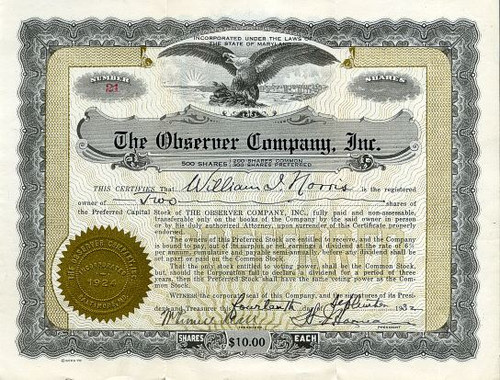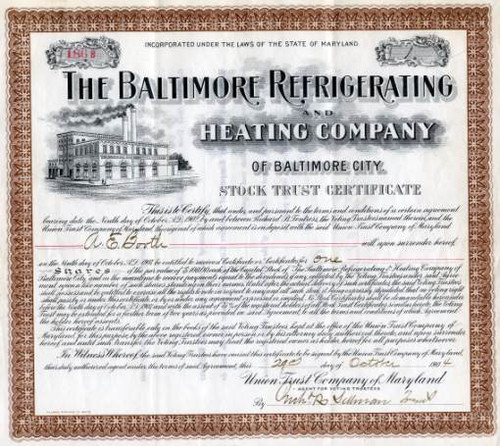Beautiful certificate from the Baltimore Trotting Races issued in 1950. This historic document was printed by Goes and has an ornate border around it with a vignette of a trotting horse with driver. This item has the signatures of the Company's President, Eugene H. Beer, Jr., and Secretary and is over 57 years old. 
Certificate Vignette New Track for Baltimore, Maryland From December 12, 1949 Harness Horse Work is under way on the site of Maryland's newest harness racing track-Baltimore Raceway-on the Pulaski Highway (Route 40) near the intersection of the Glenn L. Martin Boulevard, about 10 miles north of the center of Baltimore. About 50 men are engaged in the initial work-the gigantic task of leveling the rolling fields for the modern racing plant, which will greet fans when the inaugural meeting opens July 14. Eugene H. Beer, Jr., president of the organization, which will sponsor the races, is on hand daily as the $1,200,000 plant takes shape. He reports heavy grading work will be completed by January 1. Preliminary work on the grandstand and clubhouse will begin in a few weeks. The track itself will be built under supervision of 90-year-old J. S. Coates, Goshen, N. Y., the country's best known expert on harness race track building. The track will be located on the east side of the dual highway. The principal entrance will be from the Pulaski Highway, but other entrances and exits will be located on the Martin Boulevard. The grandstand and clubhouse will be built of reinforced concrete and steel. The grandstand will seat 6,500 persons, with 600 additional seats in the clubhouse. Parking space for 4,500 automobiles will be provided on the 150-acre tract. The stables will house 540 horses. The Pulaski Highway site was chosen after Beer and his associates lost out in a long effort to build on the site of the old Pimlico airport, in the Smith Avenue-Seven Mile Lane area of northern Baltimore. Residents of the area protested the proposal to establish the track there, and the harness racing group finally decided to locate elsewhere. The Baltimore Raceway grandstand will seat 2,500 more than that at Laurel Raceway and as many as Rosecroft Raceway and Ocean Downs combined. Rosecroft's grandstand seats 3,500, Ocean Downs' 3,000. The clubhouse will be of the same capacity as that at Laurel, but Rosecroft will still lead in that respect, its clubhouse seating 1,600. Laurel has 500 horse stalls, Rosecroft 400 and Ocean Downs 544. Baltimore, Md., May 10, 1950 A 100-foot wide chute, running parallel to the 54-stall paddock barns, will be one of the unique features of the new $1,500,000 Baltimore Raceway, Maryland's latest trotting track, which raises the curtain on its 20-night meet on July 14. A host of big-line stables have entered in the generous inaugural stake program. Laurel Raceway, which pioneered the sulky sport in a big time setting in 1948, has no such chute. Nor does Rosecroft Raceway in Oxon Hill, Md., which opens the Old Line State circuit on May 22. But the fact that Baltimore Raceway officials, such as Pres. Eugene H. Beer, Jr. and Manager Dick Hutchison, Jr., are not overlooking one thing to make the new plant "America's finest", is a sure-fire sign that all promises made to the public will be carried Out to the letter. This chute, President Beer points out, will permit the shorter races to be staged on a straightway, and make for better starts. Another important item which becomes conspicuous this past week, as work on the mammoth plant situated just off the Pulaski Highway and Martin Boulevard nine miles from downtown Baltimore was speeded up, was the elaborate lighting system. William F. Boglitch, general superintendent of the Enterprise Electric Company, said that no less than 154,000 watts from 66 poles will give the track what he terms "some of the finest illumination in the world," in addition, he said his firm was erecting 10 poles of 1500 watts each, on the parking lot, and 10 in front of the grandstand, with 1000 watts, each. Work on the raceway is way ahead of schedule, and by June 15 or 20 everything will be completed, Superintendent Parlett Davis said. All steel work on the grandstand and nearby clubhouse has been completed. The two-inch gypsum slab roof of the grandstand is on; and cement for the ground floor has been poured. The clubhouse, which will seat 650 diners, and which will be catered by the famous Harry N. Stevens, Inc., is gradually taking shape. Grading is finished. Topsoil has been poured on the infield, the 510 stalls are ready; the two paddocks of 54 stalls will be finished next week, and the grooming of the track which J. S. Coates, the 90-year-old dean of track engineers from Coshen, N. Y., laid out will be started the middle of the month.

Certificate Vignette










